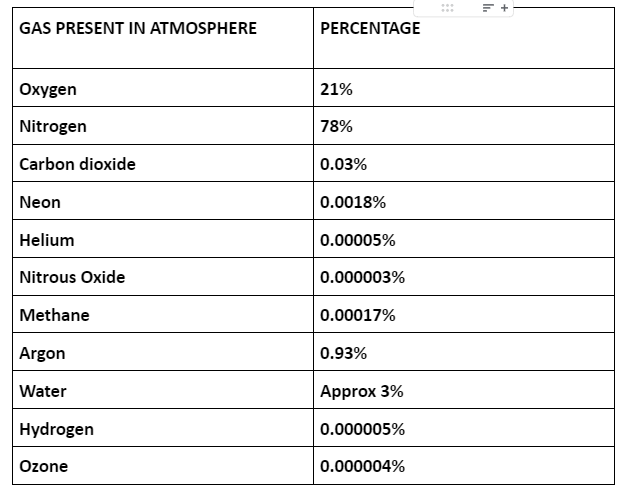Earth is the only planet that can sustain life on it and the most crucial reason behind this is the spheres of life that it has and other planets don’t. Earth is said to have no spheres of life before half a billion years ago.
It is said that earth was just like any other planet which could not sustain or grow life on it until it collided with a heavenly body in outer space, which was smaller than itself and resulted in numerous volcanic eruptions.
There was a release of molten lava all over the earth, which took millions of years to cool down. When this lava started to cool down, the gases which were produced during the eruption solidified and commenced the formation of the atmosphere. After forming the atmosphere, the other three spheres of life were created in its protection. The lithosphere is the solid rock portion of the earth, the hydrosphere is the water body and the biosphere is the life on it. This article will focus on the atmosphere and its significance for now, along with an overview of the other three spheres.
Atmosphere
The atmosphere is the layer of gases present around the earth, which creates an environment to sustain life and protects it from outer space. Half a billion years ago, it was formed due to collision and volcanic eruption, which produced various gases and solidified later. The atmosphere’s density depends upon its closeness to the earth’s surface. The closer it is, the denser it will be and as the distance rises, the density reduces. It has many layers and every layer is different in terms of height and density. The layer closest to the surface is the troposphere which starts from the surface and extends to 10 kilometres. It is the densest portion as well.
Above the troposphere is the stratosphere, which is very stable and all the flights travel in their lower portion. The Mesosphere, which is above the stratosphere, has the Karman line, which is known to be the culmination point of earth and space.
The thermosphere and the exosphere is the highest part of the earth’s atmosphere and it has the lowest temperature. Although the whole atmospheric layer is highly crucial for survival on earth, the most significant portion is the ozone layer present in the Mesosphere. The ozone layer filters the UV rays as well the x-rays coming from the sun. There are various gases present in the atmosphere, the proportion of which is given below.

Significance of Atmosphere
Various elements in the atmosphere support life and have a significant role in its sustenance. Although most of the portion of the atmosphere is covered with nitrogen, other gases and substances are considered more critical, such as oxygen and carbon dioxide. Various points of significance of the atmosphere are discussed below.
The atmosphere has oxygen which is the life-giving gas for all living creatures and things on the planet in some or the other way. For example, creatures breathe oxygen and plants use it for the purpose of photosynthesis. Carbon dioxide, which is present in the atmosphere, is equal to oxygen for plants.
The rays and light which come from the sun are incredibly harsh, intense, and dangerous for life on earth. So its balanced form on earth is that most of the ultraviolet rays and x- rays are filtered by the atmosphere.
The atmosphere is a layer of gases that covers the earth’s surface from external contact. This helps in the maintenance of optimum temperature for the growth of life.
The atmosphere maintains the water cycle. If there is no atmosphere, there would be no rain and no water. Besides this, all the changes in air and weather result from the presence of the atmosphere.
Biosphere
The biosphere is the part of the earth that contains all living things and came into existence around 3.5 billion years ago. It is a system that contains the relationship of all living things from their formation to their extinction and so on. There is a system in the biosphere where all the things are interconnected and coexist. It is often found that many things went extinct and many continue to reside depending on the kind of environment they live in. For example, plants live through photosynthesis, and animals livewire the food available to them.
Hydrosphere
All the water bodies on earth are part of the Hydrosphere, which has been present on earth for more than 4 billion years now. Life On earth started from water bodies and not land. Initially, It formed in water and further expanded to land. Even today, it is said that the most dynamic and most prominent form of life exists in the oceans, most of which remains to be discovered. Most of the earth’s surface is covered with water and it continues to change in shape and size due to various events on the planet.
Lithosphere
The outermost, rock-hard layer of the Earth’s surface is called the lithosphere. It even comprises the fragile part of the crust and the rigid top layer of the mantle. This layer is about 100 Kilometres thick. The Earth’s lithosphere consists of solid loose materials from rocks. The most unique feature of the Earth’s lithosphere is the presence of ‘Tectonic activity’. Tectonic activity is associated with the contact between huge pieces of the lithospheric layer. Any disturbance in these plate positions is the causative reason for a number of natural disasters, like earthquakes, volcanos, etc.
Conclusion
Earth is the planet that sustains life because of the atmosphere and the different spheres formed. Life is precious and so are the elements protecting it. The atmosphere is the layer that prevents any kind of external object from entering the earth and maintains life on it. It is hugely significant and life cannot be imagined in its absence.
 Profile
Profile Settings
Settings Refer your friends
Refer your friends Sign out
Sign out




